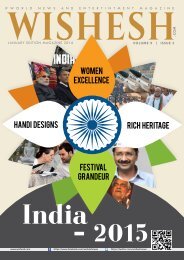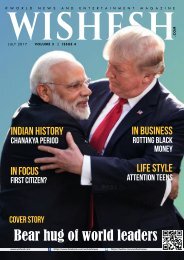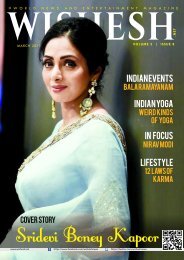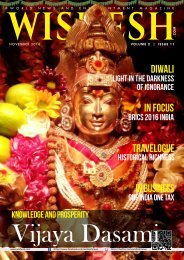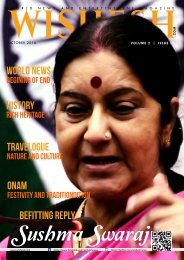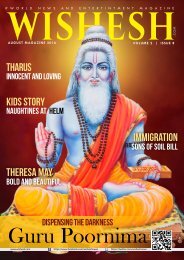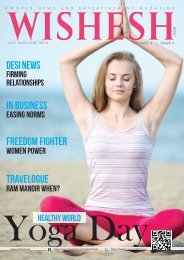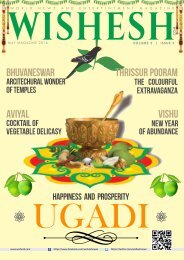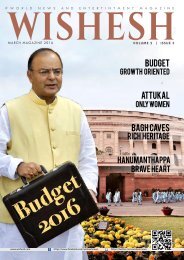Wishesh Magazine June 2016
Here is the Latest June Edition of Wishesh Magazine. World Largest Gathering Ujjain Kumbh Mela as a cover story and more Interesting Stories of Kodalampatti Handloom Saries, NRI Profiles, Healthy Living, Festivals, Politics, Automobiles, Technology , Spiritual , Travelogue and Many More exciting stories on Wishesh Magazine.
Here is the Latest June Edition of Wishesh Magazine. World Largest Gathering Ujjain Kumbh Mela as a cover story and more Interesting Stories of Kodalampatti Handloom Saries, NRI Profiles, Healthy Living, Festivals, Politics, Automobiles, Technology , Spiritual , Travelogue and Many More exciting stories on Wishesh Magazine.
Create successful ePaper yourself
Turn your PDF publications into a flip-book with our unique Google optimized e-Paper software.
INDIAN DIASPORA TRADITION<br />
14<br />
part of their lifestyle. This<br />
tribe inhabits in the dense<br />
hilly forests in the eastern<br />
part of the Satpuras,<br />
in Shahdol, Bilaspur,<br />
Rajnandgaon, Mandla,<br />
and Balaghat districts. The<br />
Baigas are of Dravidian<br />
stock and are one of the<br />
eight prime tribes of M.P.<br />
It is believed that this tribe<br />
is an offshoot of the Bhuiya<br />
tribe of Chhota Nagpur. A<br />
distinguishing feature of<br />
the Baiga tribe is that their<br />
women are famous for<br />
sporting tattoos of various<br />
kinds on almost all parts of<br />
their body. The women who<br />
work as tattooing artists<br />
belong to the Ojha, Badni<br />
and Dewar tribes of M.P.,<br />
and are called Godharins.<br />
They are extremely<br />
knowledgeable about the<br />
different types of tattoos<br />
preferred by various tribes.<br />
Their mothers traditionally<br />
pass on this knowledge to<br />
them. Tattooing amongst<br />
the tribals commences with<br />
the approach of winter and<br />
continues until summer.<br />
recognized as a variety of<br />
Chhattisgarhi influenced by<br />
Gondi and Western Hindi.<br />
Most Baigas communicate<br />
with outsiders in Hindi and<br />
some of them also knows<br />
a few local languages like<br />
Gondi or Marathi depending<br />
on the region they live in.<br />
Baigas eat coarse grain,<br />
kodo and kutki, drink pej,<br />
eat little flour. One of the<br />
prime foods is pej that can<br />
be made from grounding<br />
macca or from the water left<br />
from boiling rice. This food<br />
is much better and healthier<br />
than many other food that<br />
they eat. They eat several<br />
items from the forest that<br />
includes primarily Chirota<br />
Bhaji, Gular leaves such as<br />
Chirota, chinch, chakora,<br />
sarroota, peepal etc.<br />
They also eat BirarKand,<br />
Kadukand and other<br />
rhizomes. Mushroom is<br />
also a delicacy. Numerous<br />
fruits such as mango, char,<br />
jamun, tendu are also<br />
eaten. They hunt as well,<br />
primarily fish and small<br />
mammals.<br />
The ancestors of the Baigas<br />
spoke an Austroasiatic<br />
language, however no<br />
trace of it is left now. Some<br />
Baigas have mentioned<br />
“Baigani” as their mother<br />
tongue. Baigani is now<br />
WWW.WISHESH.COM | JUNE <strong>2016</strong>





